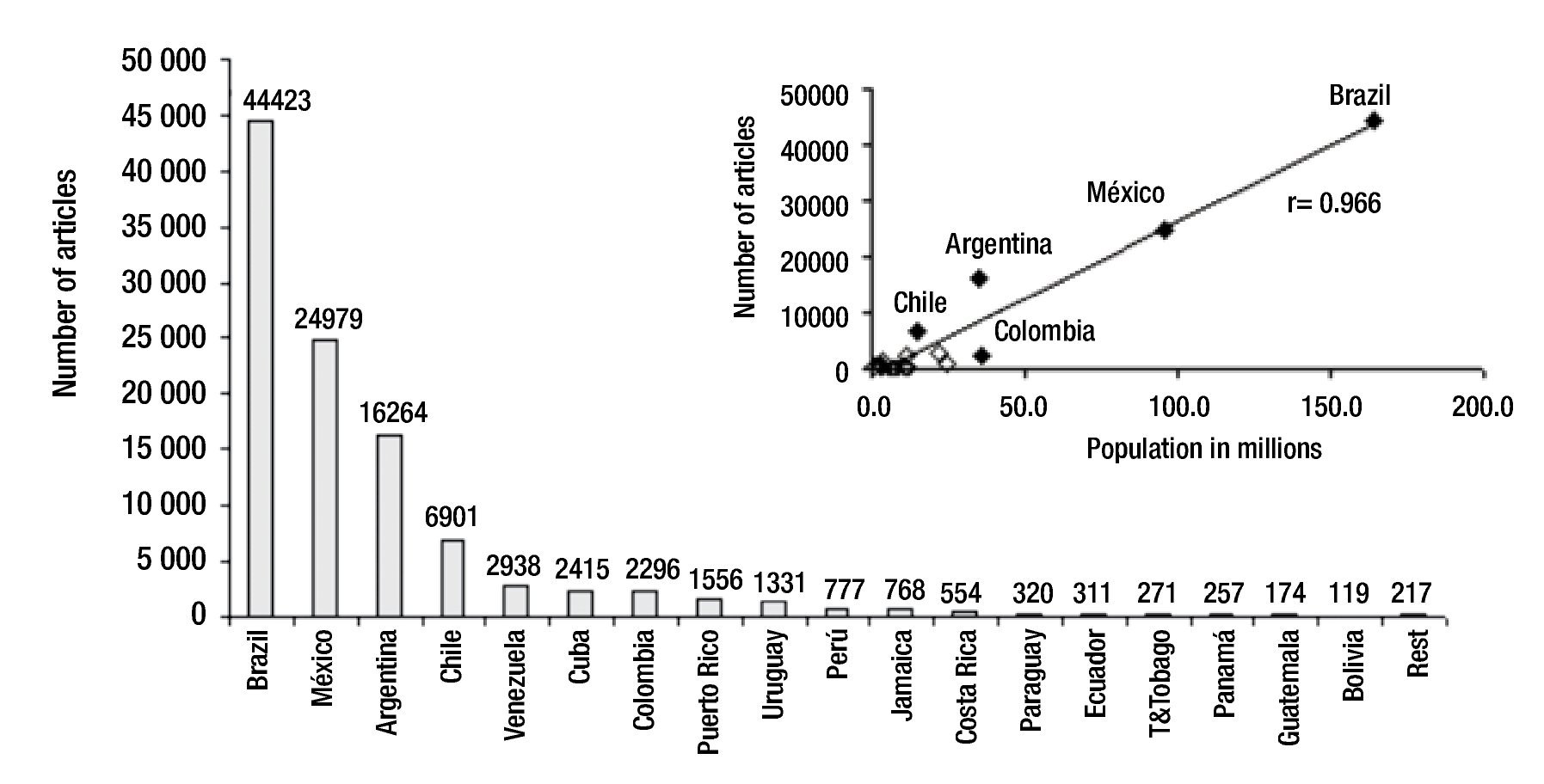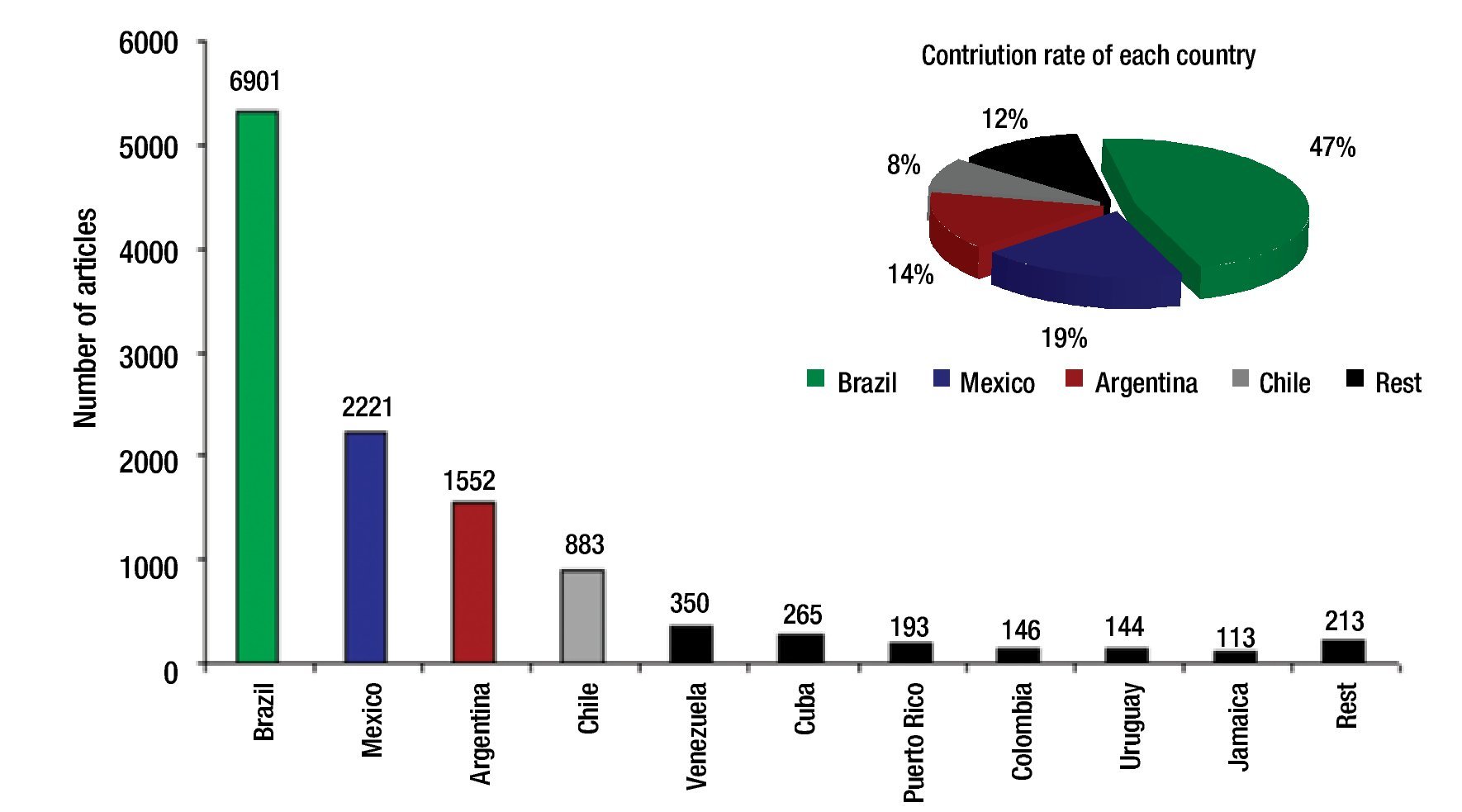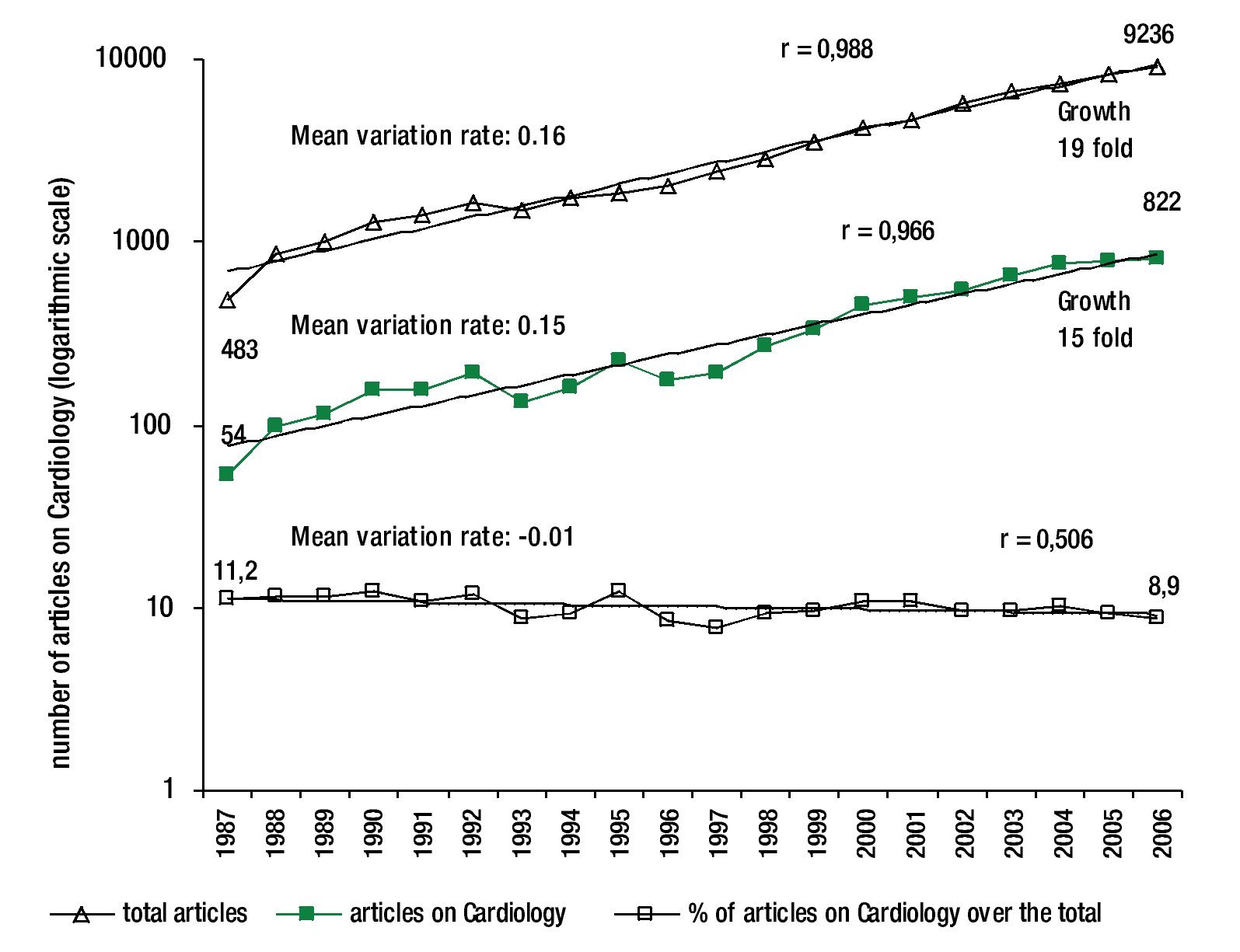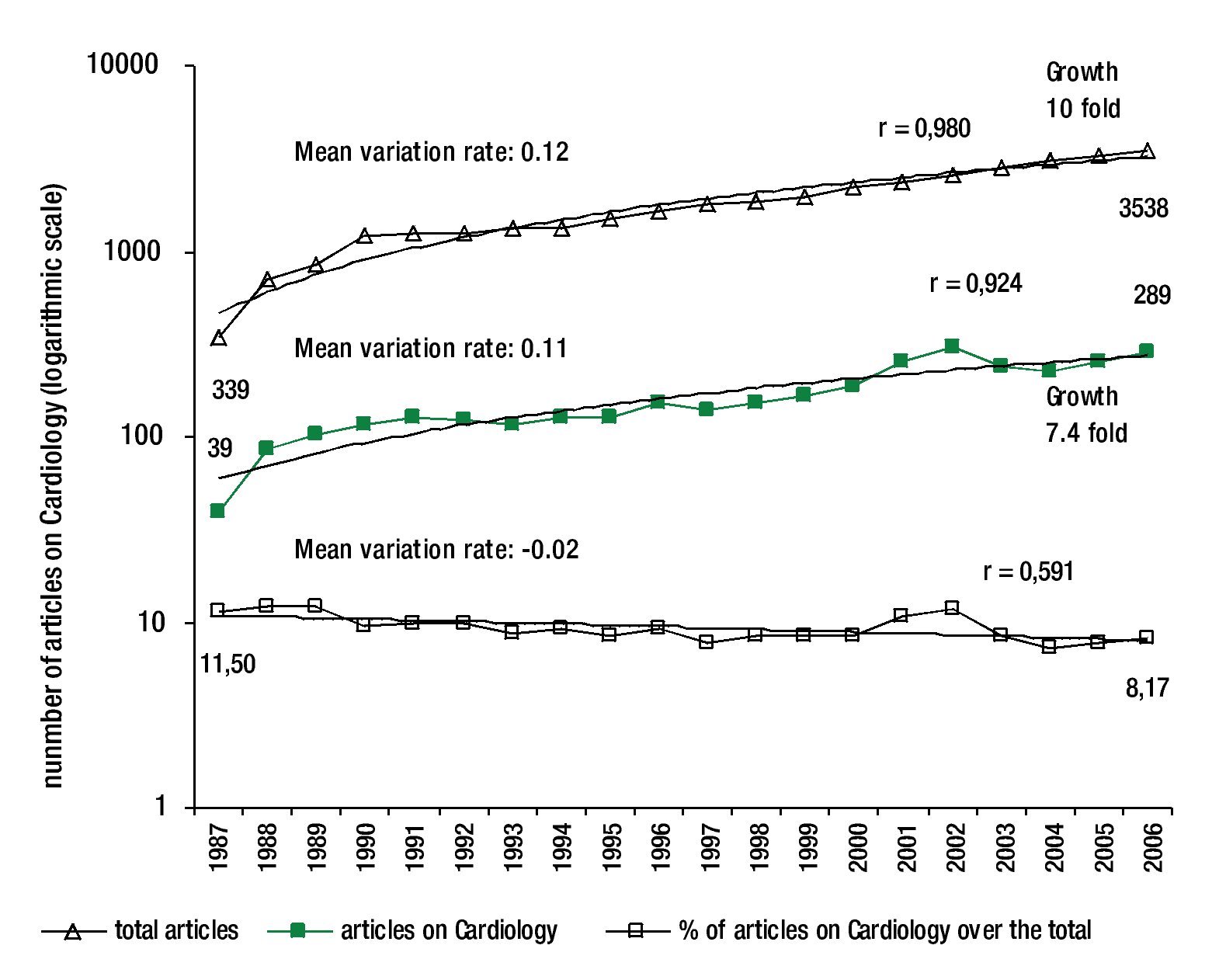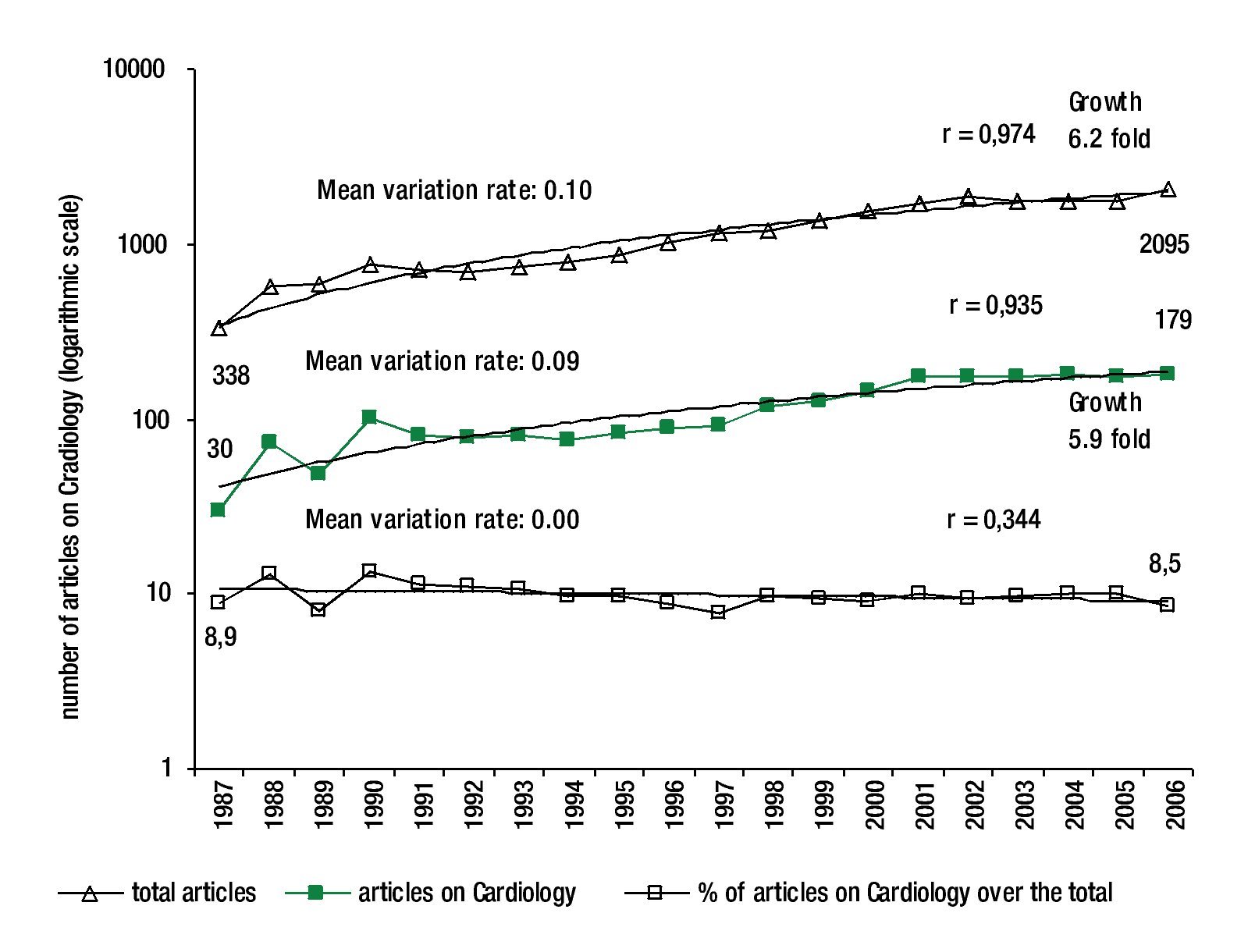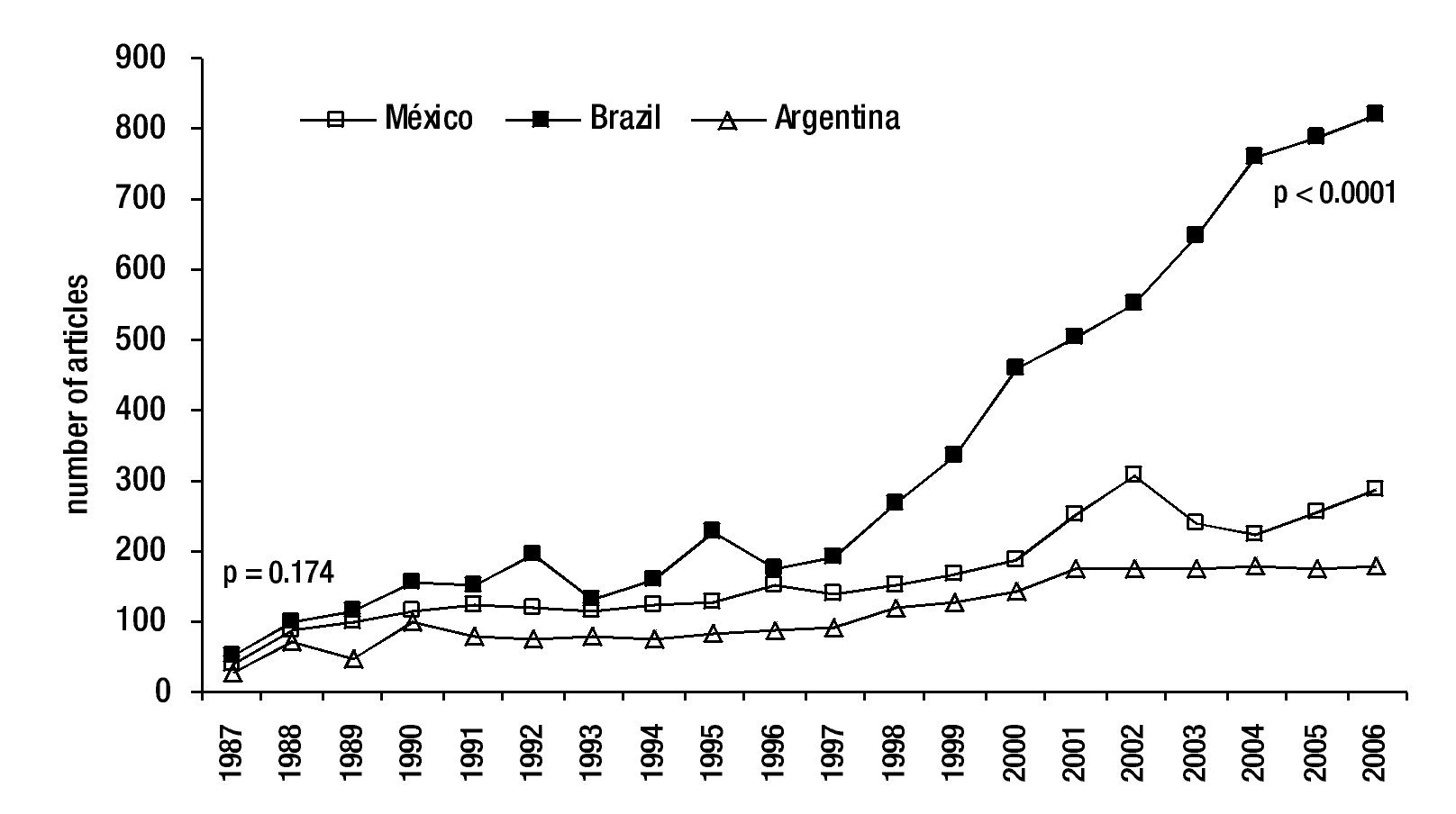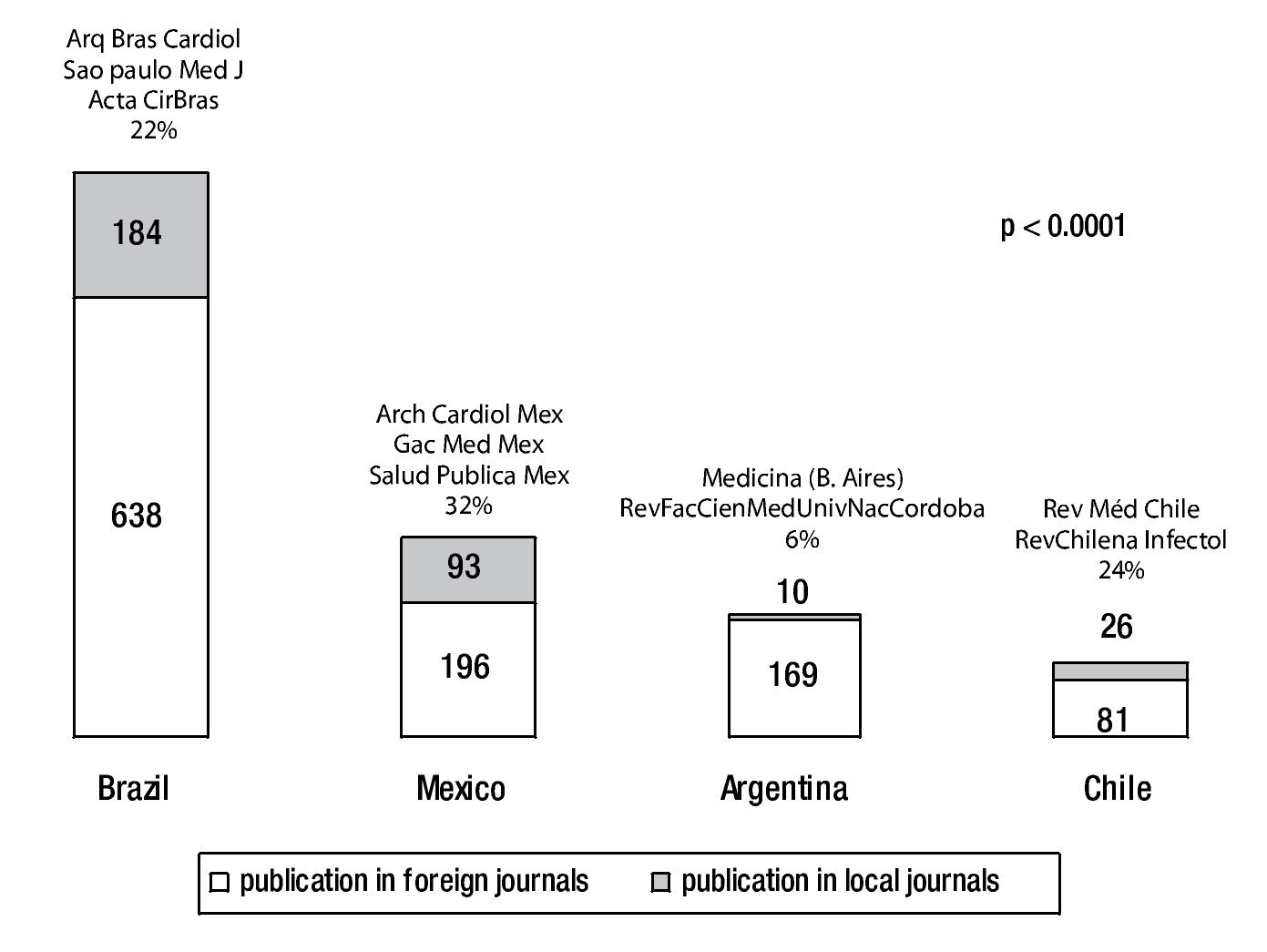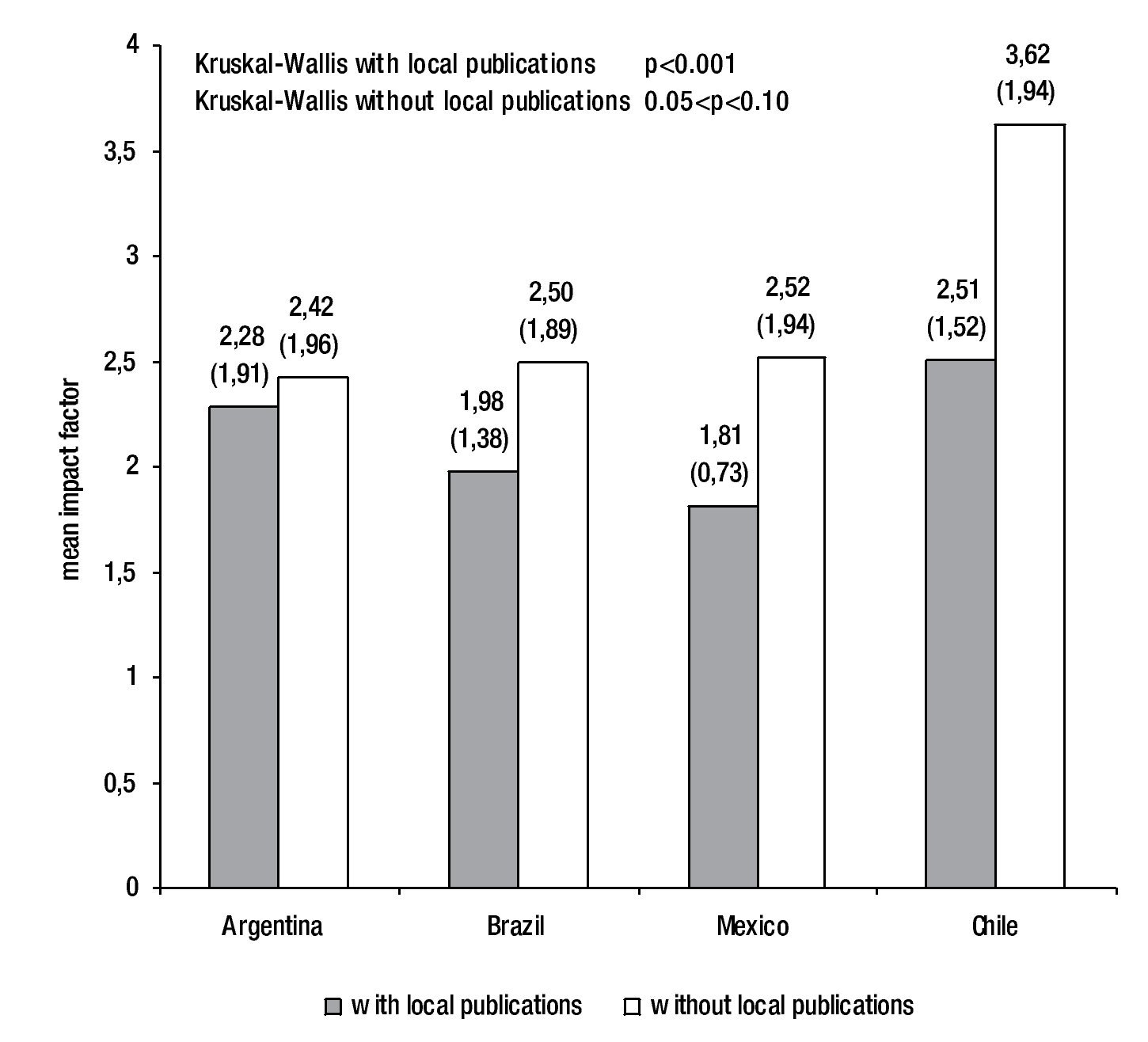Introduction
Several indicators have been developed to evaluate the scientific production of a region or country; one of them is the number and quality of the articles published in international journals. In medicine, these articles are usually included in the Medline database of the National Libraries of Medicine of the USA that allows, among other things, to select the number and type of articles per region, country and specialty. In 2003, Latin America and the Caribbean published 2.2% of the references in Medline, which represents a 30% increase compared to 1999.1 Also, the estimates of global production in cardiovascular research disease suggest that Latin America has substantially increased the number of articles published in the region from 1995 to 2002.2 Although this trend points out a favorable situation for the region, the individual contribution of each country seems to be very unequal when this global index is disaggregated.1 Historically, some Latin American countries have played an important role in the Latin American scientific production in Cardiology, but it has been rarely quantified in terms of volume and number of publications as bibliometric indicators throughout the years. In that sense, the assessment of the published articles on clinical and basic research in Cardiology, according to its characteristics and trends, is of strategic importance to know each country's position in the context of the region, and may be useful to design policies for the scientific promotion of the specialty.
Objective
To assess the production of articles on Cardiology research published by the different Latin American countries in recent years in international journals, to evaluate the characteristics and trends throughout time, and to compare results among countries in the region.
Methods
A bibliography search was carried out throughout PubMed in regard to biomedical articles in general and on Cardiology in particular, corresponding to the period 1997 - 2006 (10-year-long) for all the Latin American countries, afterwards extended to the period 1987 - 2006 (20-year-long) for the top-four countries with the largest contribution of articles. The Medline database used in this study includes about 15 million references to biomedical articles and information from approximately 4,500 journals from 70 countries. On the other hand, the PubMed database provides free access to Medline and has an interface that allows the access of articles through several search strategies.3 To identify the articles from different Latin American countries, different filters were used.4 Mainly the restrictive criteria, country, to identify the first author's affiliation or the place of origin of the publication was employed; «cardio*» was used with the same restrictive function to select the sites where the articles originated, and the temporal limit function to enclose different time periods. Additionally, Mesh terms incorporated in the Appendix, were included in the search. The same search strategy was used for each Latin American country, taking into account language differences (e.g., Brasil and Brazil, Argentina and Argentine).
Based on the compilation of this information, a descriptive analysis was performed on the number of medical publications in general and on Cardiology per country, the impact factor of the journals where the articles were published in 2006, the trends, the increases and the rates of temporal variation for Brazil, Mexico, and Argentina since 1987 were also assessed. For the establishment of the mean impact factor, the information of the Journal Citation Report (base 2003) compiling different bibliometric indexes was used.5
Statistical analysis. Data were expressed as absolute values, percentages, averages, or median and the comparisons among countries were performed with Chi square or Kruskal-Wallis assuming non-Gaussian distributions. The trends of the chronological series were adjusted with linear or exponential regression, and Pearson's coefficient r was used for each one of them. In addition, the mean rates of annual variation for each temporal series and the growth index were estimated.
Results
With the proposed search strategy, 106,871 biomedical articles were identified as well as 11 416 articles on Cardiology published in the last 10 years (1997 - 2006) from Latin American countries in Medline-indexed journals. This corresponds to a rate of 10.6% articles related to cardiovascular disease over the total published. The number of articles in all the medical areas that were published by country is observed in Figure 1 with Brazil in the first place, followed by Mexico, Argentina, and Chile. In the flowchart attached to the figure, a good correlation between the number of inhabitants per country and the number of published articles can be observed. On the other hand, the comparison with the Gross National Product of each country showed a similar correlation (flowchart not included). In the same Figure it can be observed that Argentina and Chile are above the regression line, and its hypothetical projections to a population similar to the Brazilian would correspond to the double of publications in the latter country. In regard to the Colombian projection, it would correspond to a fourth of the Brazilian production.
Figure 1. Number of articles in medicine published in the last 10 years (1997 - 2006) generated in Latin America (PubMed), and its relation with the number of inhabitants.
Figure 2 shows the number of articles exclusively on Cardiology published in the same decade, and the contribution rate of each country. Besides, Brazil outgrows Mexico in these types of publications, whereas Argentina and Chile are placed in the third and fourth place, respectively.
Figure 2. Number of articles on Cardiology published in the last 10 years (1997-2006) generated in Latin America (PubMed) and contribution rate of each country.
Figure 3 confirms the growth trend of the medical and Cardiology publications from Brazil, Mexico, and Argentina in the last 20 years (1987 - 2006) (it is worth mentioning that the Y axis is represented in logarithmic scale). It is shown that the growth of the publications on general medicine is slightly greater than that of the publications on Cardiology. In the first case, the mean variation rates from Brazil (Figure 3a), Mexico (Figure 3b), and Argentina - (Figure 3c) show that the annual increase was in average 16%, 12% and 10% since 1987, respectively for each country, whereas the articles on Cardiology had an annual average growth of 15%, 11% and 9%. In addition, the comparison of the growth in the number of articles published since 1987 up to date shows that the number of Brazilian publications is greater than that from Mexico and Argentina whether in articles on Cardiology or biomedical articles in general. Figure 4 shows the growth of articles from these 3 countries (decimal scale).
Figure 3a. Trend in the publication of articles on medicine, Cardiology, and rate over the overall publication in the last 20 years, originated in Brazil.
Figure 3b. Trend in the publication of articles on medicine, Cardiology, and rate over the overall publication in the last 20 years, originated in Mexico.
Figure 3c. Trend in the publication of articles on medicine, Cardiology, and rate over the overall publication in the last 20 years, originated in Argentina.
Figure 4. Comparison of the growth of articles on Cardiology from Brazil, Mexico, and Argentina.
The comparison of the number of articles published per country is not complete if some quality indicator is not taken into consideration. Figure 5 shows the number and rate of the articles published during 2006 in Brazil, Mexico, Argentina, and Chile, in local and foreign journals (all of them indexed in Medline)
Figure 5. Comparison of the number and rate of publications in local and foreign journals from Brazil, Mexico, Argentina, and Chile in 2006.
In the first place, we observed that Brazil was also ahead in the number of articles on Cardiology during 2006. In the second place, almost one fourth of the articles from Brazil were published in local indexed journals (Arq Bras Cardiol [0.322], Sao Paulo Med J [0.134], Acta Cir Bras [0.153]), approximately one third of the publications from Mexico in other local publications (Arch Cardiol Mex [0.245], Gac Med Mex [0.081], Salud Publica Mex [0.379]), one fourth from Chile in Rev Méd Chile (0.353) or Rev Chilena Infectol (0.271), and only 6% of the publications from Argentina in Medicina (B. Aires) (0.364) or Rev Fac Cien Med Univ Nac Cordoba (without data) edited in that country (values between brackets correspond to mean impact factor for 2006). This shows that the latter country published more articles abroad than Brazil, Me- xico, and Chile (P <0.0001). On the other hand, it shows the impact that a local, Medline-indexed journal, can have on the visibility of the volume of publications from a given country.
A second indicator of the quality of the publications was obtained from measuring the impact factor of the journals where the articles on Cardiology were published by each country during 2006. The bar graph on the left in Figure 6 shows that the impact factor was in average greater in the publications from Chile and Argentina compared to Brazil and Mexico (P <0.001). When local publications (Medicina [B. Aires], Arq Bras Cardiol, Arch Cardiol Mex, Rev Méd Chile, etc.) were extracted from the measurement, the impact factor significantly increased for all the countries due to the number of articles published in their local indexed journals and their lower impact factor.
Figure 6. Mean (and median) impact factor of the journals where the articles on Cardiology were published by Argentina, Brazil, Mexico, and Chile in 2006.
Discussion
The analysis of the individual contribution of each country in the number of articles on Cardiology included in Medline showed that -in order of importance- Brazil, Mexico, and Argentina contributed with 80% of the publications from Latin America between 1997 and 2006. The magnitude of the growth in the number of articles on Cardiology since 1987 was between 5.9- and 15-fold in these same three countries. Brazil shows a significant greater increment in the number of publications after 1998 when compared with Mexico and Argentina (Figure 4).
Based on the data from Figure 5, it can be estimated that almost one fourth of the articles from Mexico, Brazil, Argentina, and Chile were published in a local, Medline-indexed journal. This is a common characteristic also observed in non-Anglo speaking countries of Eastern Europe and Japan, for example, which usually publish in a local journal.6 Hence, although Chile and Argentina were in the fourth and third place in terms of number of publications, the mean impact factor of the journals where these countries published in 2006 was significantly greater than that from Brazil and Mexico. Since Brazil has the greatest number of national indexed journals (37 publications) of the region, an explanation to the lower average impact factor could be found in the lack of self-citation. However, the limitations of the impact factor to measure the quality of a journal should be taken into consideration.7,8
When the contribution of Latin America to the major 50 biomedical journals is analyzed, it can be observed that between 1995 and 2002, in average, the region alone contributed with 0.4% of the overall medical general publications, outgrowing Eastern Europe (0.3%) and Africa (0.2%).9 On the other hand, the productivity of articles on research in Cardiology reached and average of 1.1% for the period 1995 - 2002.2 Comparatively, in a bibliometric analysis of the production of articles in respiratory medicine, it was observed that between 1995 and 2003 Latin America contributed with 1.09% of the publications on respiratory diseases, outgrowing only Africa with 0.80%.10 On the other hand, in regards to productivity in the area of parasitology, the region contributed with 17.2% of the worldwide publications registered in PubMed, with an increase of 50% from 1995 to 2003.11
Assessment of scientific production based on the number of biomedical contributions is an area of continuous interest in all countries. Besides being able to identify the references to a particular subject or matter, some authors have built geographical filters with the objective of individualizing the production of each region or province within the same country, a feature that is not present in the PubMed search option.12
The decision of presenting the relation between the number of published articles and the number of inhabitants, instead of the number of investigators or the Gross National Product (GNP) was based on the difficulty in obtaining confident data from all the countries of the region. However, the comparison with the GNP showed a similar correlation.
One of the limitations of this study could be found in the search strategy used. The restrictive criterion «cardio*» and the Mesh terms (see Appendix) used to select the origin and type of the publication could pose a bias for the individualization of the articles, though the manual review of each publication did not show inconsistencies. Also, by not restricting the search exclusively to the "cardiac and cardiovascular systems" category of the "Journal Citation Report", articles published in journals of general medicine and other similar specialties could have been included.2 Finally, in spite of being the most important, Medline database is not the only source for medical bibliographical search, and this point could be considered an additional limitation of this study.
Publication of locally generated research is essential both to guarantee our knowledge of cardiovascular diseases affecting Latin American countries and because this information is a faithful reflection of our specific social and healthcare needs. Unfortunately, changes in budget and in the frequency with which some regional publications appear have had highly negative consequence in international appreciation of Latin American journal quality. Similarly, although some local journals are duly encouraged and recognized by universities and scientific institutions, a paradoxical situation remains in which these publications are undervalued or discriminated when compared to foreign publications. With reference to international bibliometric databases, from a total of 14 Latin American journals on cardiology, only two are included in Medline. In addition to the lack of local indexed journals, trends to prefer publication on a foreign journal could be supported because many regional studies, widely quoted locally, are underrepresented in international index evaluations, perhaps due to a negative bias on the part of many researchers to quote studies in languages other than English. Therefore, it is obviously necessary to increase the number of Medline-indexed publications and to improve the quality, dissemination and international prestige of Latin American journals.13
Conclusion
The scientific production on Cardiology from Latin America was assessed, based on the number of publications indexed in Medline. This product shows strong differences among the countries of the region, and Brazil, Mexico, and Argentina alone account for 80% of the publications. Brazil appears to have led the region, especially since 1998. From the quality of the articles point of view, assessed by the impact factor, Chile and Argentina appear better positioned. This information could be useful not only to evaluate the individual status of each country but to establish more adequate policies in regard to the promotion of science.
Appendix: Mesh terms incorporated in the search
("Cardiomyopathies"[Mesh] OR "Cardiomyoplasty"[Mesh] OR "Cardiology"[Mesh] OR "Cardiomyopathy, Dilated"[Mesh] OR "Diagnostic Techniques, Cardiovascular"[Mesh] OR "Cardiology Service, Hospital"[Mesh] OR "Cardiomyopathy, Hypertrophic"[Mesh] OR "Pregnancy Complications, Cardiovascular"[Mesh] OR "Cardiomyopathy, Hypertrophic, Familial"[Mesh] OR "Chagas Cardiomyopathy"[Mesh] OR "Cardiopulmonary Resuscitation"[Mesh] OR "Cardiovascular Surgical Procedures"[Mesh]) OR ("Cardiotonic Agents"[Mesh] OR "Cardiovascular Infections"[Mesh] OR "Cardiovascular Abnormalities"[Mesh] OR "Tuberculosis, Cardiovascular"[Mesh] OR "Cardiovascular Diseases"[Mesh] OR "Cardiovascular Agents"[Mesh] OR "Cardiopulmonary Bypass"[Mesh] OR "Cardioplegic Solutions"[Mesh] OR "Cardiomyopathy, Restrictive"[Mesh] OR "Syphilis, Cardiovascular"[Mesh] OR "Cardiomyopathy, Alcoholic"[Mesh] OR "Shock, Cardiogenic"[Mesh] OR "Heart Arrest, Induced"[Mesh]) OR ("Electrocardiography"[Mesh] OR "Defibrillators, Implantable"[Mesh] OR "Atrial Natriuretic Factor"[Mesh] OR "Electric Countershock"[Mesh]) OR ("Myocarditis"[Mesh]) OR ("Hypertension"[Mesh] OR "Hypertension, Pregnancy-Induced"[Mesh] OR "Hypertension, Renovascular"[Mesh] OR "Hypertension, Renal"[Mesh] OR "Hypertension, Pulmonary"[Mesh]) OR ("Arrhythmia"[Mesh] OR "Anti-Arrhythmia Agents"[Mesh] OR "Arrhythmia, Sinus"[Mesh]) OR ("Pacemaker, Artificial"[Mesh]) OR ("Myocardial Ischemia"[Mesh] OR "Electrocardiography, Ambulatory"[Mesh] OR "Myocardial Reperfusion Injury"[Mesh] OR "Coronary Disease"[Mesh] OR "Angina Pectoris"[Mesh]) OR ("Heart Rupture, Post-Infarction"[Mesh] OR "Myocardial Infarction"[Mesh] OR "Pulmonary Embolism"[Mesh]) OR ("Electrophysiology"[Mesh]) OR ("Angioplasty, Balloon, Laser-Assisted"[Mesh] OR "Angioplasty, Transluminal, Percutaneous Coronary"[Mesh] OR "Angioplasty, Balloon"[Mesh] OR "Angioplasty, Laser"[Mesh]) OR ("Heart Valve Diseases"[Mesh] OR "Pulmonary Valve Insufficiency"[Mesh]) AND ("Country"[Affiliation]) AND ("Date"[EDAT])
Corresponding author: Raúl A. Borracci.
La Pampa 3030 1°B, 1428. Buenos Aires, Argentina.
E-mail address: raborracci@gmail.com
Received on November 22, 2010;
accepted on August 18, 2011.




